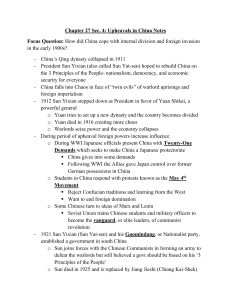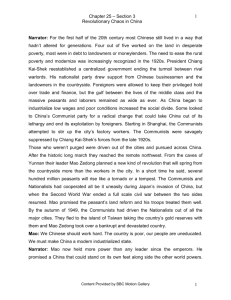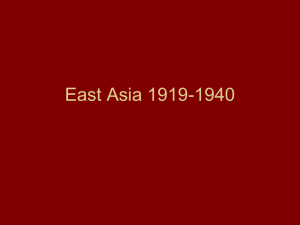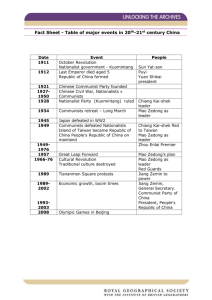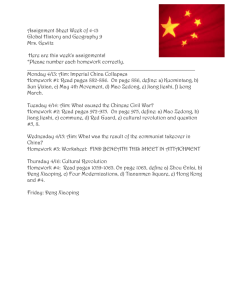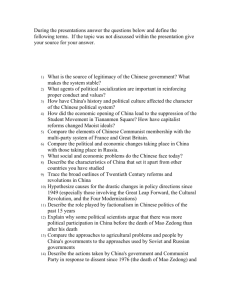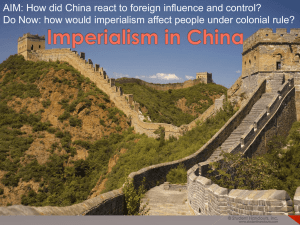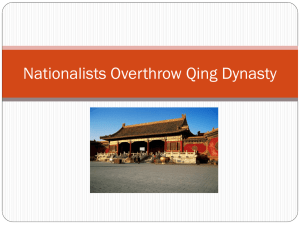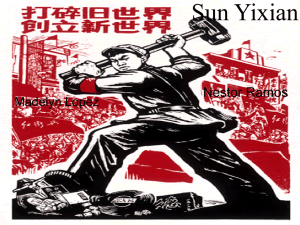The Chinese Republic in Trouble
advertisement
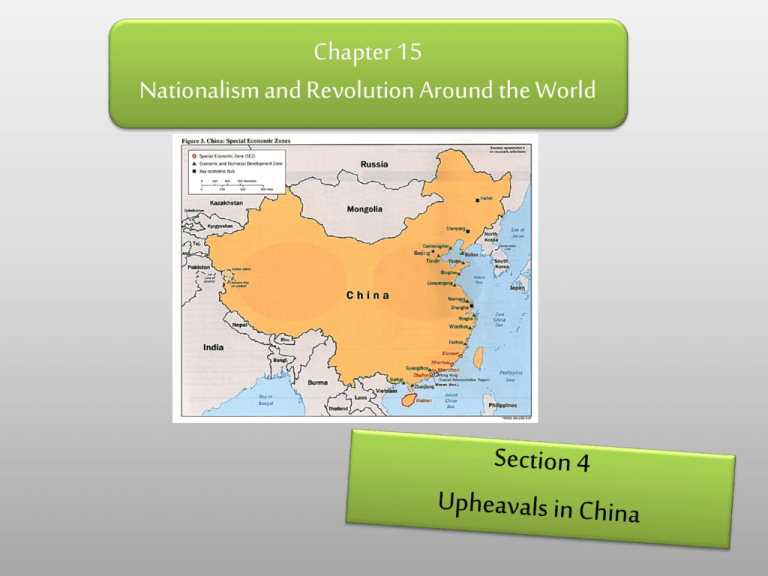
Chapter 15 Nationalism and Revolution Around the World Objectives for this section: *Explain the key challenges faced by the Chinese republic in the early 1960s. *Analyze the struggle between two rival parties as they fought to control China. *Describe how invasion by Japan affected China. The Chinese Republic in Trouble China’s Qing dynasty collapsed in 1911. The president of China’s new republic, Sun Yixian hope to rebuild China on the Three Principles of the people: *Nationalism *Democracy *Economic Security Unfortunately, Sun made little progress. China quickly fell into chaos in the face of the “twin evils” of warlord uprisings and foreign imperialism. The Warlord Problem In 1912, Sun Yixian stepped down as president in favor of Yuan Shikai, a powerful general. Sun hoped that Yuan would create a strong central government, but instead, the ambitious general tried to set up a new dynasty. The military however, did not support Yuan, and opposition divided the nation. When Yuan died in 1916, China plunged into still greater disorder. In the provinces, local warlords seized power. As rival armies battled for control, the economy collapsed and millions of peasants suffered terrible hardships. China was also struggling with widespread famine and attacks by bandits. Foreign Imperialism During this period of upheaval, foreign powers increased their influence over Chinese affairs. Foreign merchants, missionaries, and soldiers dominated the ports China had opened to trade. During WWI, Japanese officials presented Yuan Shikai with the Twenty-One Demands (list of demands that would allow Japan to assume power over China so that it could protect China). With China too weak to resist, Yuan gave in to some of the demands. Then, in 1919, at the Paris Peace Conference, the Allies gave Japan control over some former German possessions in China. That news infuriated Chinese Nationalists. May 4th Movement *Student protests in Beijing in response to Paris Peace Conference because the Allies gave Japan control over some former German possessions in China. *Protests spread to cities across China. *May 4th Movement was organized to strengthen China. Reformers in China rejected learning from the West. Women played a key role in the Movement. They joined marches and campaigned to end a number of traditional practices. Their work helped open doors for women in education and the economy. The Appeal of Marxism Some Chinese turned to the revolutionary ideas of Marx and Lenin. The Soviet Union was more than willing to train Chinese students and military officers to become the vanguard (elite leaders of a communist revolution). By the 1920s, a small group of Chinese Communists had formed their own political party. Struggle for a new China In 1921, Sun Yixian and his Guomindang (Nationalist party) established a government in South China. Sun planned to raise an army, defeat the warlords, and spread his government’s rule over all of China. When Western democracies refused to help, Sun accepted aid from the Soviet Union and joined forces with the small group of Chinese Communists. However, he still believed that China’s future should be based on his Three Principles of the People (nationalism, democracy, economy). Jiang Jieshi Leads the Nationalists After Sun’s death in 1925, an energetic young army officer, Jiang Jieshi took over the Guomindang. Jiang was determined to smash the power of the warlords and reunite China, but he had little interest in either democracy or communism. In 1926, Jiang began the Northern Expedition in cooperation with the Chinese Communists. In the Northern Expedition, Jiang led the combined forces into northern China, crushing or winning over local warlords as he advanced and capturing Beijing. Jiang would go on to take control of a new government led by the Guomindang. This new government did not feature communism. Jiang was against communism. In 1927, he ordered troops to kill Communist party members and workers who supported them. Thousands of people were killed. This massacre marked the beginning of a bitter civil war between the Communists and the Guomindang that lasted for 22 years. Mao Zedong and the Communists Among the Communists who escaped Jiang’s attack was a young peasant revolutionary named Mao Zedong. Unlike earlier Chinese Communists, Mao believed that the Communists should seek support not among the small urban working class but among the large peasant masses. Mao and the Communists redistributed land to peasants and promised other changes. The Long March Jiang was determined to destroy the “Red Bandits” (Communists). He led the Guomindang in a series of campaigns against them. The Guomindang harassed Mao’s retreating army throughout the Long March from 1934-1935. Mao’s forces used guerrilla warfare (ambush attacks) to fight back. At the end of the Long March, the Communists set up a new base in a remote region of northern China. There, Mao rebuilt his forces and plotted new strategies for fighting the Guomindang. The Long March Continued During the march the Communists soldiers were ordered to treat peasants politely, pay for goods they wanted, and avoid damaging crops. Such behavior made Mao’s forces welcome among peasants. Japanese Invasion While Jiang was pursuing the Communist across China, the country faced another danger. In 1931, Japan invaded Manchuria in northeastern China, adding it to the growing Japanese empire. As Japanese aggression increased, a group within the Guomindang forced Jiang to make an alliance with the Communists against Japan. In 1937, the Japanese struck again, starting what became the Second Sino-Japanese War. Airplanes bombed Chinese cities, and Japanese troops overran eastern China, including Beijing. On December 13th, 1937, Japanese troops marched into the city of Nanjing (important cultural center & Guomindang capital). After the city’s surrender, the Japanese killed hundreds of thousands of soldiers and civilians. The united Chinese fought back against the Japanese. The Soviet Union sent advisors and equipment to help. Great Britain, France, and the United States gave economic aid. Looking Ahead The bombing of Pearl Harbor in 1941 brought the United States into the war against Japan and into an alliance with the Chinese. By the end of WWII, Jiang and the Guomindang controlled China’s central government, but Mao’s Communist Party controlled much of northern and central China. The Communists had organized hundreds of thousands of Chinese peasants at the village level, spreading their political ideas. Meanwhile, corruption grew in Jiang’s government. Soon, the Communist would triumph, and Mao would impose revolutionary change to China.
